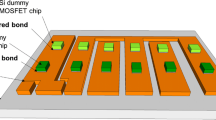Abstract
Silver electrochemical migration (ECM) is a serious reliability issue for fine pitch as well as power electronic devices that employ silver as interconnection materials. In this study, a method to suppress the ECM behavior of silver was proposed and implemented. Solid solutions of Ag–In and intermetallic compounds were fabricated and their ECM properties were studied through the water drop test (WDT). The WDT was performed on alumina substrate in deionized water at 3 V, where the leakage current was measured. The results show that Ag–In alloy samples have considerably longer lifetime before reaching short circuit than pure silver samples. As indium concentration in Ag–In solid solution increases, the resistance to ECM also increases. The migration process is completely inhibited when the indium concentration reaches 19 at.%. The morphologies of the dendrites and surfaces of the anode and cathode were also investigated. A model was established to explain the anti-ECM mechanism of Ag–In alloys. By forming indium oxide on the surface of the anode under electric field in a humid environment, the anode gets passivated and the silver dissolution path is completely blocked, and thus inhibiting the ECM process. It was discovered that the quality of electrode surfaces is essential in realizing the full potential of the inherent anti-ECM ability of Ag–In alloys. In conclusion, the results of this investigation have shown that Ag–In alloys can be promising and valuable candidates for conductors, metallization, and interconnect materials in fine pitch and high power electronic devices.













Similar content being viewed by others
References
B. Medgyes, B. Illes, G. Harsanyi, Electrochemical migration behaviour of Cu, Sn, Ag, and Sn63/Pb37. J. Mater. Sci.: Mater. Electron. 23, 551–556 (2012)
M.S. Jung, S.B. Lee, H.Y. Lee, C.S. Ryu, Y.G. Ko, H.W. Park, Y.C. Joo, Improvement of electrochemical migration resistance by Cu/Sn intermetallic compound barrier on Cu in printed circuit board. IEEE Trans. Dev. Mater. Reliab. 14(1), 382 (2014)
D.Q. Yu, W. Jillek, E. Schmiitt, Electrochemical migration of Sn–Pn and lead free solder alloys under distilled water. J. Mater. Sci.: Mater. Electron. 27, 219–227 (2006)
J.W. Yoon, B.I. Noh, S.B. Jung, Electrical properties and electrochemical migration characteristics of directly printed Ag patterns with various sintering conditions. Microelectron. Reliab. 54, 410–416 (2014)
T. Takemoto, R.M. Latanision, T.W. Eagar, A. Matsunawa, Electrochemical migration tests of solder alloys in pure water. Corros. Sci. 39, 1415–1430 (1997)
J.C. Lin, J.Y. Chan, On the resistance of silver migration in Ag-Pd conductive thick films under humid environment and applied d.c. field. Mater. Chem. Phys. 43, 256–265 (1995)
J.C. Lin, J.Y. Chuang, Resistance to silver electrolytic migration for thick-film conductors prepared from mixed and alloyed powders of Ag-15Pd and Ag-30Pd. J. Electrochem. Soc. 144(5), 1652–1659 (1997)
C.A. Yang, C.R. Kao, H. Nishikawa, Development of die attachment technology for power IC module by introducing indium into sintered nano-silver joint. In The IEEE 67th Electronic Components and Technology Conference (ECTC), San Diego, 2017
C.A. Yang, C.R. Kao, H. Nishikawa, C.C. Lee, High reliability sintered silver-indium bonding with anti-oxidation property for high temperature applications. In The IEEE 68th Electronic Components and Technology Conference (ECTC), San Diego, 2018
C.A. Yang, S. Yang, X. Liu, H. Nishikawa, C.R. Kao, Enhancement of nano-silver chip attachment by using transient liquid phase reaction with indium. J. Alloys Compd. (2018). https://doi.org/10.1016/j.jallcom.2018.05.254
Y.Y. Wu, D. Nwoke, F.D. Barlow, C.C. Lee, Thermal cycling reliability study of Ag-In joints between Si chips and Cu substrates made by fluxless processes. IEEE Trans. Compon. Packag. Manuf. Technol. 4(9), 1420–1426 (2014)
Y. Huo, J. Wu, C.C. Lee, Study of anti-tarnishing mechanism in Ag–In binary system by using semi-quantum-mechanical approach. J. Electrochem. Soc. 164(7), C418–C427 (2017)
B.I. Noh, S.B. Jung, Characteristics of environmental factor for electrochemical migration on printed circuit board. J. Mater. Sci.: Mater. Electron. 19, 952–956 (2008)
B.I. Noh, J.B. Lee, S.B. Jung, Effect of surface finish material on printed circuit board for electrochemical migration. Microelectron. Reliab. 48, 652–656 (2008)
G.Q. Lu, W. Yang, Y.H. Mei, X. Li, G. Chen, X. Chen, Mechanism of migration of sintered nano-silver at high temperatures in dry air for electronic packaging. IEEE Trans. Dev. Mater. Reliab. 14(1), 311–317 (2014)
T. Kawanobe, K. Otsuka, Metal migration in electronic components. In IEEE Transactions on Components, Hybrids, and M. Technology, CHI-781, pp. 220–228 (1982)
Z. Bahari, J. Rivet, B. Legendre, J. Dugué, Study of the Ag-In-Te ternary system. II. Description of the quadrilateral Ag-Ag2Te-In2Te3-In. J. Alloys Compd. 289, 99–115 (1999)
D.C. Harris, Quantitative Chemical Analysis, 7th edn. (W.H. Freeman, Company, New York, 2006), (APPENDIX H)
Acknowledgements
The financial supports of Ministry of Education of Taiwan through grant 107L9006 and Ministry of Science and Technology of Taiwan through grants 107-3017-F-002-001 and 104-2221-E-002-040-MY3 are acknowledged. The Advanced Research Center of Green Materials Science and Technology is supported by the Featured Areas Research Center Program within the framework of the Higher Education Sprout Project of Taiwan. The authors would like to thank Prof. Peter Burke of the Department of Electrical Engineering and Computer Science in University of California, Irvine for providing the pico-ammeter equipment, and Industrial Technology Research Institute of Taiwan for providing the nano-silver paste.
Author information
Authors and Affiliations
Corresponding author
Rights and permissions
About this article
Cite this article
Yang, C.A., Wu, J., Lee, C.C. et al. Analyses and design for electrochemical migration suppression by alloying indium into silver. J Mater Sci: Mater Electron 29, 13878–13888 (2018). https://doi.org/10.1007/s10854-018-9520-3
Received:
Accepted:
Published:
Issue Date:
DOI: https://doi.org/10.1007/s10854-018-9520-3




